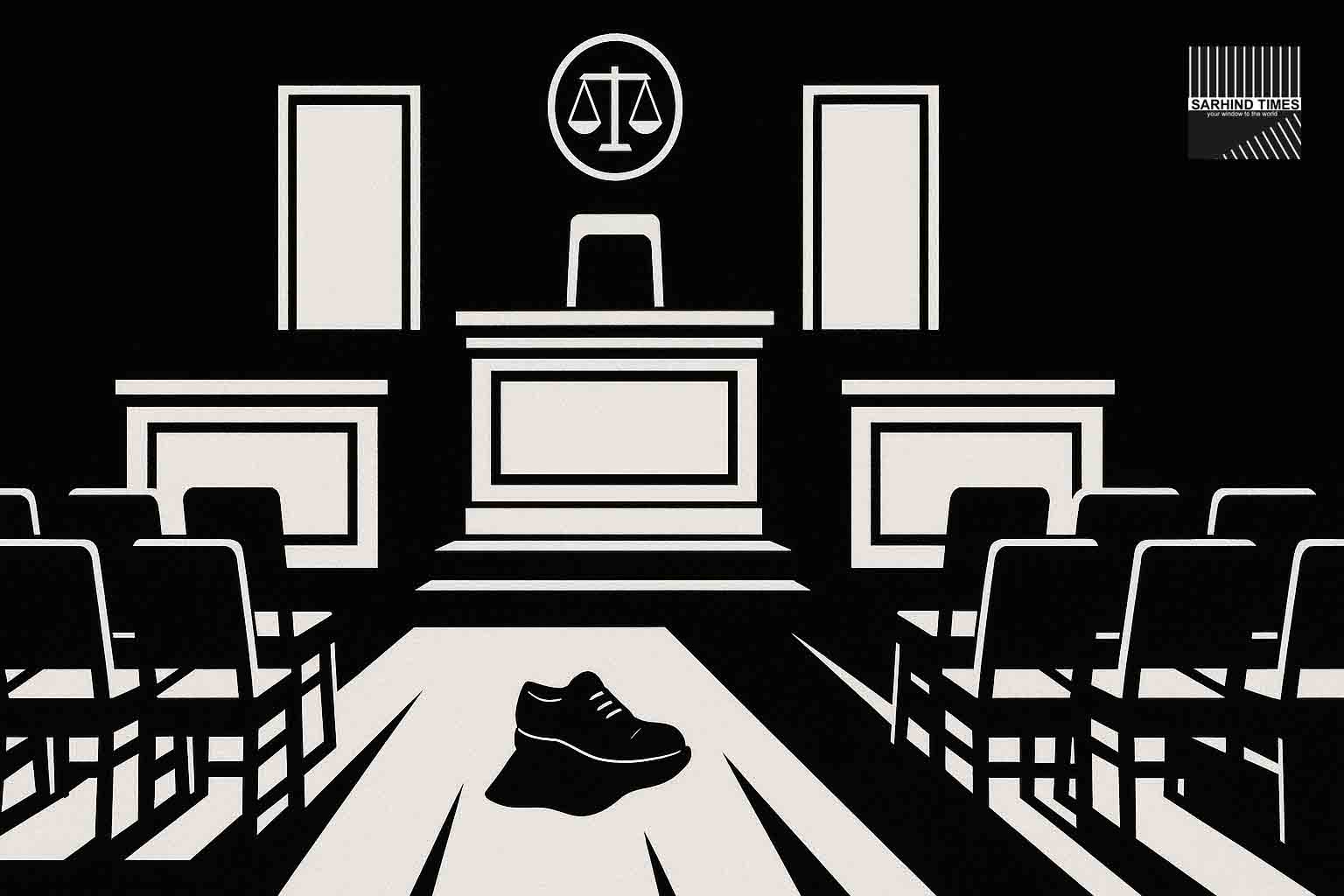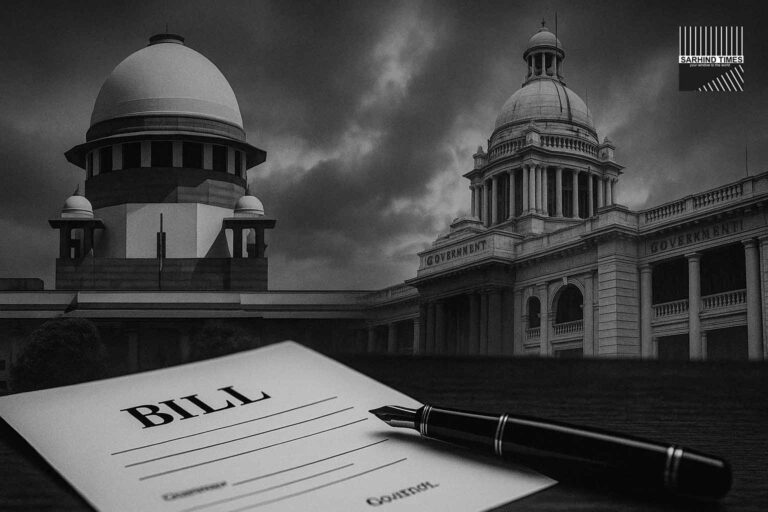New Delhi, October 7, 2025 — In a moment that jolted the precincts of India’s highest court, an advocate attempted to hurl a shoe at Chief Justice of India B.R. Gavai during a live session on October 6. The act, executed in full view of fellow lawyers and bench officers, has sparked uproar across political, legal, and social spheres. Outcry has transcended party lines. As the judiciary absorbs shock and recalibrates security, deeper questions about institutional sanctity, faith-based provocation, and courtroom access emerge.
Introduction
At approximately 11:35 am in Court No. 1 of the Supreme Court, Advocate Rakesh Kishore—a 71-year-old enrolled with the Bar Council of Delhi—removed a sports shoe and attempted to toss it toward the bench, shouting slogans including “Sanatan dharma ka apmaan nahi sahega Hindustan” (We will not tolerate any insult to Sanatan Dharma).
The object did not reach the dais. Court security intervened immediately, restraining him and whisking him out.
CJI Gavai, in the face of this disruptive provocation, instructed that court proceedings continue. “These things do not affect me,” he told the gathered lawyers, and calmly presided over the remaining matters on schedule.
Within hours, the Bar Council of India (BCI) provisionally suspended Rakesh Kishore from legal practice, citing conduct “inconsistent with the dignity” of the profession.
Prime Minister Narendra Modi, along with senior opposition leaders, issued statements condemning the act as a “direct attack on democracy” and “assault on constitutional integrity.”
But beyond the immediate drama lie deeper questions: how did someone with courtroom access attempt such an act? What role did prior remarks by the CJI play in inflaming sentiment? And how must the judiciary and state respond to preserve dignity without undermining access or free expression?
This article unpacks the incident, examines its legal and social ramifications, and places it in the context of India’s evolving debates around faith, dissent, and institutional respect.
Who Is Rakesh Kishore?
Professional background & affiliations
Kishore has been a registered advocate since at least 2009 with the Bar Council of Delhi. He held identity cards from multiple bar associations—including the Supreme Court Bar Association, Shahdara Bar Association, and Bar Council of Delhi—several of which were found in his possession.
His long standing in the profession suggests he was neither a novice nor an outsider, making his act all the more jarring for observers.
Motivation & declared grievance
According to police sources, Kishore was angered by earlier remarks attributed to CJI Gavai during a hearing on a plea to restore a damaged Lord Vishnu idol in Khajuraho. In dismissing the petition, Gavai had said:
“Go and ask the deity himself to do something. If you are a strong devotee of Lord Vishnu, then you pray and meditate.”
Observers note that this remark had sparked online backlash, with critics charging it was an insensitive reduction of devotional sentiment.
Kishore reportedly carried a hand-written note that read:
“Mera sandesh har sanatani ke liye hai … Sanatan dharma ka apmaan nahi sahega Hindustan.”
He also invoked slogans as security moved him out.
Yet while motive may be claimed, the boundary between protest and assault in a court is sharply drawn by law.
Legal Response & Institutional Reaction
Immediate suspension & show cause
Within hours of the incident, the BCI issued an interim order suspending Kishore from appearing, acting, pleading or practising before any court, tribunal or authority in India. A show cause notice is expected, asking him to respond why suspension should not persist or escalate.
The BCI also directed that any court or bar body using identity cards or proximity passes must void Kishore’s access.
Court’s treatment & leniency
Notably, sources in Indian Express report that CJI Gavai instructed the Supreme Court Registry not to press formal preventive action against the advocate and directed his release from the court premises. The Delhi Police later returned his shoes and documents and allowed him to leave within the court complex.
That gesture was controversial: some legal voices saw it as an act of judicial magnanimity, others as missed opportunity to emphasize deterrence.
Legal options & precedents
Under the Advocates Act, 1961 and BCI Rules on Professional Conduct and Etiquette, gross misconduct such as assault or attempted assault grants disciplinary authority.
In addition, the Indian Penal Code (IPC) offers recourse: under sections for assault or criminal intimidation, the state may press criminal charges. Some have urged invoking contempt of court provisions, given the target was the nation’s top judiciary.
Yet legal observers caution that overzealous action risks chilling dissent—even inside courtrooms—so balanced, proportionate responses are key.
Security changes & access review
In wake of the breach, the Supreme Court’s security establishment is reported to be reviewing access protocols. Suspicion has focused on how Kishore secured proximity to the bench via a court access card or pass.
Some suggest mandatory revalidation of passes, biometric checks inside court zones, and strategic screening before courtroom entry. The challenge will be to walk the line between firm security and preserving litigants’ access.
Political Reaction & Institutional Solidarity
Across the political spectrum
Prime Minister Modi condemned the act, saying it “angered every Indian,” praising CJI Gavai’s composure. BJP leaders described it as an “unacceptable assault on the sanctity of the judiciary.”
Opposition figures—including Rahul Gandhi, Sonia Gandhi, and party chief Mallikarjun Kharge—called it an attack not merely on Gavai but on constitutional faith, democracy and judicial dignity.
State leaders also weighed in: in Kerala, Chief Minister Pinarayi Vijayan condemned the act as a symptom of “poisonous communal propaganda” fanning intolerance.
Bar associations & legal fraternity response
The Supreme Court Bar Association (SCBA) issued a rapid statement expressing “profound shock, outrage, and unequivocal condemnation.”
In Bengaluru, senior advocates questioned how an officer of the court could resort to violent gesture instead of raising objections in argument.
Law societies in Maharashtra and Goa described the act as an “attack on our statute” and demanded a comprehensive probe.
Some senior legal voices have raised the specter of whether this was a caste-tinged or faith-triggered provocation, given Gavai’s Dalit background and recent controversies around his remarks on religious monuments.
Deeper Implications: Faith, Dissent & Institutional Respect
Interpreting provocation in the name of religion
The attacker invoked “Sanatan Dharma” explicitly, linking his motive to a perceived affront to Hindu symbolism. Analysts see this as part of a rising pattern where religious sentiment may be weaponised to incite extreme gestures.
But what distinguishes a right to protest from violent outburst in a court? The symbolism of a shoe thrown at a judge is explosive—historically understood as degrading gesture.
A commentary in The Wire frames it starkly: the impunity with which a 71-year-old lawyer threw a shoe at a Dalit CJI without immediate legal escalation reveals a deep fault line in Indian democracy.
Polarisation, social media & echo chambers
Some commentators argue that online rumour amplification and selective quoting have fuelled anger far beyond the courtroom. The merging of judicial discourse and identity fault lines—caste, religion—makes every remark a flashpoint.
In such a climate, institutions cannot remain insulated from social turbulence. But they must also resist being dragged into performative responses.
Preserving courtroom decorum without muzzling dissent
Courts must not become austere fortresses inaccessible to contestation. At the same time, extreme gestures must be unequivocally disavowed. The judiciary must balance access, transparency, and order.
Legal reforms may include stricter codes of conduct, speedy trials of attacks on the institution, and capacity for deescalation protocols inside courtrooms.
Broader Context & Historical Echoes
History of “shoe-gate” in Indian politics and protest
Throwing footwear is a potent symbol in Indian and global protest culture. In India’s modern history, political figures, ministers, or public figures have previously faced shoe attacks as symbolic censure.
But rarely has a sitting Chief Justice been targeted this way inside a courtroom. That pushes the boundary of protest to institutional insult.
Judicial controversies & sensitivities
This incident did not arise in a vacuum. In September 2025, the CJI’s remarks in the Khajuraho idol case—dismissing the petition as “publicity interest litigation” and telling petitioners to “ask the deity himself to act”—had drawn wide debate and criticism.
Gavai later clarified publicly that he respects all religions and clarified the context of his remarks.
Still, the sensitive mix of faith, symbolism, judicial language and public perception set the stage for larger conflict.
Institutional equilibrium & trust deficit
The attack also underscores a trust deficit: when citizens perceive institutional pronouncements as disrespectful to beliefs, the reaction can escalate. Courts must remain acutely aware of how language, metaphor, and framing resonate with volatile cultural currents.
What Happens Now: Key Watchpoints
- Disciplinary and criminal action
- Whether criminal charges (assault, contempt) are formally filed
- Final decision by BCI after show cause reply
- Security overhaul in Supreme Court
- Revalidation of proximity access
- Introduction of biometric or frisking zones
- Real-time intrusion alerts
- Dialogue on judicial language & sensitivity
- Supreme Court may issue guidelines on phrasing or context in sensitive matters
- Bench seminars or orientation on cultural & religious sensitivity
- Precedent for dissent within courtrooms
- Establishing boundaries: permissible objection vs. disruptive gestures
- Clarifying red lines for court decorum
- Public confidence & symbolic messaging
- Joint statements by judiciary, bar, political leadership
- Media management to avoid mischaracterisation
Voices from around the field
- CJI Gavai (in court): “Don’t get distracted by all this … these things do not affect me.”
- PM Modi (on X): “Spoke to Chief Justice … The attack on him … has angered every Indian. There is no place for such reprehensible acts in our society.”
- BCI Chairperson in suspension order: Kishore’s act “appears inconsistent with the dignity of the court.”
- Senior advocate (Bengaluru): “Advocates are officers of the court and cannot resort to such violent dissent.”
- Kerala CM Pinarayi Vijayan: Characterised the attack as driven by communal hate, linking it to years of ideological propaganda.
Towards Institutional Healing
To emerge stronger, India’s judiciary and civil polity must address three axes in tandem:
- Firm deterrence, fair process: The offender must face due disciplinary and (if warranted) criminal sanction—not as spectacle but demonstration of rule-based consequence.
- Transparent security reform: Changes must be systemic, not ad hoc, ensuring that court precincts remain safe without restricting genuine litigant movement.
- Dialogue, sensitivity & trust: The bench may benefit from dedicating forums for ongoing engagement with civil society, religious groups and bar bodies to anticipate friction points.
If the judiciary is seen as a monolithic, aloof fortress, it loses legitimacy. If it is seen as vulnerable to provocation, its authority erodes. The balance is delicate—but essential for democratic stability.
























+ There are no comments
Add yours